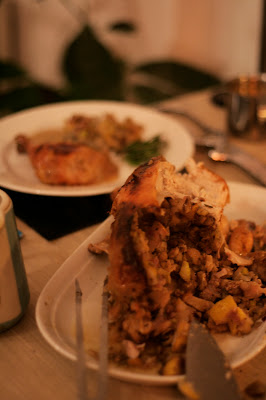I have to admit, I never really cooked a whole bird before. Breast, yes. Legs, yes. But a whole bird? Never. I know it's not that difficult on the one hand. But on the other things can go wrong easily, as well. My biggest fear is dry meat.
I found this recipe on the website of German Brigitte magazine and altered it a little bit. I didn't want to go with something as elaborate as goose, duck or turkey right away. But this chicken with chestnut stuffing sounded perfect. Just a chicken, but with some fancy and wintery extras and ingredients. Wohoo!
Unfortunately it turned out a little too dry in the end. I decided to cook the chicken in a terracotta cassserole (Römertopf) instead of steaming it beforehand, as the original recipe suggested. The terracotta gets soaked in water for at least ten minutes before and keeps whatever meat is inside nice and moist. Unfortunately the chicken looked quite pale, even though the meat was already cooked. So after removing the lid I had to cook it for another 30-45 minutes in order to fry/broil the skin.
That caused some dryness in the breast sections. But hey! My first bird! Next time I will just take the lid off earlier, so that this won't happen again. And besides that, it was delicious!
Here's what you need:
1 red onion, chopped
400g/14 oz. chestnuts (pre-cooked, peeled and vacuum-sealed)
80g/2.8 oz. butter or margarine
1 pear, core removed, cut into cubes
2 celery stalks, chopped
5 twigs of fresh majoran (I only had dried one)
(A few fresh twigs of rosemary and thyme)
3 tbsp maple syrup
salt, freshly ground pepper
1 chicken (organic, approx. 1.5kilos/3.3 pounds)
1 garlic clove, finely chopped
200 ml / ¾cups white wine/cidre (or apple juice)
400ml / 1¾ cups chicken broth (in a glass)
150g / ⅔ cups creme fraiche
Directions
Halve 250g (a bit more than half of the total amount) of the chestnuts.
Mix with onion cubes and sauté both with 20g /0.7oz. butter until onions are translucent.
Mix in chopped celery and pear cubes. Remove the leaves from 3 majoran twigs and add them to the mixture, as well. Stir in 1tbsp maple syrup and season to taste with salt and freshly ground pepper.
Rinse the chicken under cold water, cleaning the in- and outside and dry it with paper towel.
Rub it with salt (in- and outside, as well).
Fill the chicken with as much chestnut-pear mixture as possible and close it up with tooth picks or small iron spits.
Carefully place some herbs (twigs of rosemary, thyme, majoran) directly underneath the skin. Just try to separate the skin from the meat and push the herbs between. That adds some extra nice flavour!
Preheat the oven to a maximum of 180°C (the lower the longer it needs to cook, but the better and more tender the meat gets.
In the meantime soak a terracotta casserole for at least ten minutes in warm water.
Brush the bottom of the cassserole with a bit of oil. Place the chicken in the casserole, close the lid and cook the chicken for about 30-45minutes. In the meantime melt 40g/1.4oz butter. Remove the lid and cook for another 30-45 minutes at 180°C. To give it a proper tan while keeping it moist and adding some flavour brush the chicken top with melted butter and maple syrup, one at a time, every 10-15minutes. If the skin gets too dark before the meat is fully cooked, just cover it up with some aluminium foil. You know that the chicken is done when the meat comes off the leg bones. This is a pretty good indicator for all kinds of poultry. Once you notice it cook it maybe 10-15 minutes longer, just to make sure. But it should be about perfect!
While the chicken is in the oven puree the rest of the chestnuts (you might wanna add some of the chicken broth to make it easier to puree). Sauté garlic with the leftover butter in a saucepan.
Add chicken broth and white wine, bring to a boil and let simmer for 10 minutes, do not cover.
Stir in creme fraiche then the pureed chestnuts. Season to taste with salt, pepper and maybe some of the maple syrup and serve the sauce with the chicken.
Yum!
PS: If you have a tip on how to get chicken unresitibly moist, let me know. One info ahead: the minimum temperature of our gas oven is 150°C. That's as low as it gets...
The original recipe didn't use rosemary and thyme just majoran and didn't glaze the chicken with maple syrup, just melted butter. They also added honey instead of maple syrup to the pear-chestnut mix.













